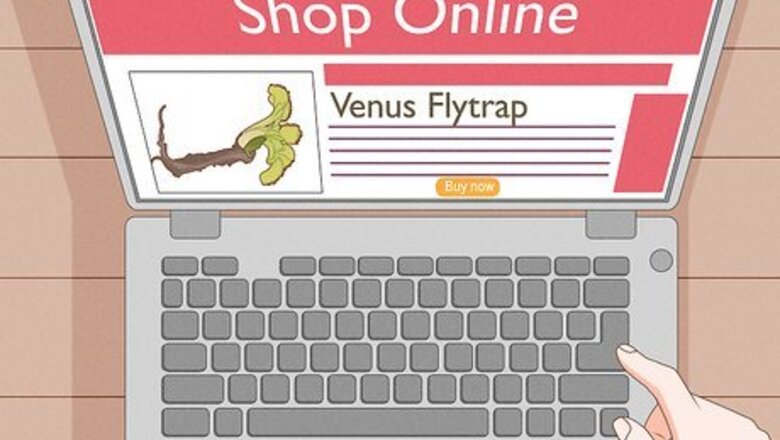
views
Planting a Venus Flytrap

Buy a Venus flytrap bulb. The most common, and easiest, way to start growing a Venus flytrap is to purchase a bulb (or several bulbs) from a company that specializes in growing the plants. Search online to find a vendor from which you can mail order bulbs. You'll be able to choose from among several varieties that have differences in shape and color. You may also be able to find a nursery in your area that sells Venus flytrap bulbs. While it's less common, you can certainly grow a Venus flytrap from seed as well - bearing in mind that it could take up to 5 years for the seed to become a mature plant. Order seeds online and germinate them in deep pots filled with a seed substrate composed of sphagnum moss. Place the pots in plastic bags to keep the environment warm and moist. Once the seedlings have sprouted, you can transplant them to a more permanent growing medium.
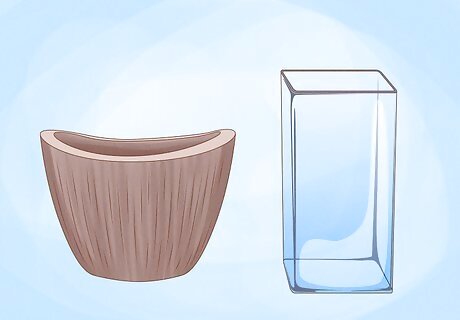
Choose a growing container. Since Venus flytraps require high humidity, a glass growing container is an excellent choice. This is especially true if you live in growing zone 7 or lower, where the winter temperature gets too cold for the Venus flytrap. If you live in growing zone 7 or lower, consider planting the Venus flytrap in a terrarium. The high sides of the terrarium will keep heat and moisture trapped in, helping the Venus flytrap thrive. Airflow is important, though, so don't plant it in a container with a lid. A fishbowl or another glass container with an opening works well. A glass pot or a regular clay pot with drainage holes both work fine if you live in a warm climate with mild winters - growing zone 8 or higher.
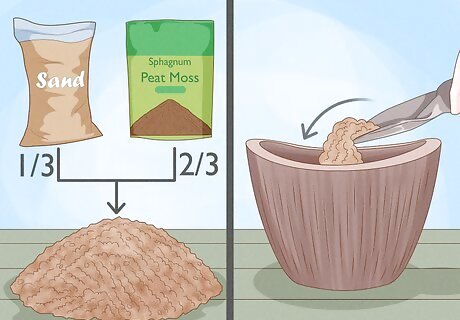
Make a soil mixture for the Venus flytrap. This plant naturally grows in very poor soil, and gets most of its nutrients by eating insects and spiders. In order to replicate the plant's natural growing medium, make a mixture of 2/3 sphagnum moss and 1/3 sand. If you plant a Venus flytrap in regular potting soil, it won't thrive. Regular potting soil contains too many nutrients. Never add lime or fertilizer to a Venus flytrap's growing medium. If you're using a terrarium, line it with gravel and place the soil mixture on top, so that you can ensure the soil will drain adequately.
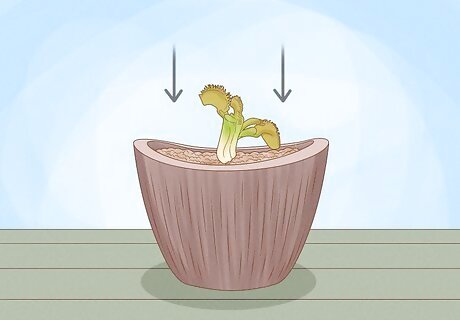
Plant the bulb root side down. Dig a small hole in the soil and plant the bulb so that the top of the bulb is even with the soil. If you started your Venus flytrap from seed, plant the sprouted seedling so that the bulb is under the soil and the green stems are exposed to the air. After planting the Venus flytrap, providing the right environment and food will help it grow and thrive.
Providing Sunlight and Water
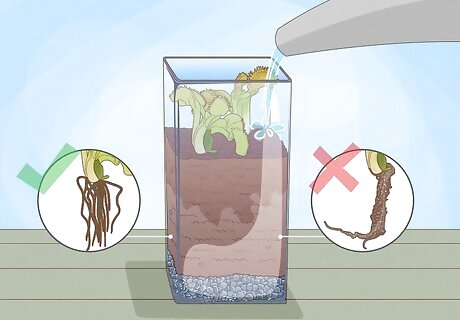
Keep the soil moist. The Venus flytrap is native to Carolina boglands, where the soil is constantly wet. It's very important that the soil in your Venus flytrap's pot or terrarium be kept moist to mimic its natural habitat. That said, the Venus flytrap should not be kept in standing water; make sure the pot or terrarium drains well so that the plant doesn't rot.
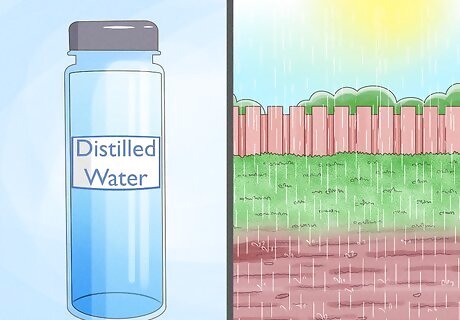
Use rainwater or distilled water. Tap water is usually too alkaline-heavy or contains too many minerals to use to water a Venus flytrap. An easy way to get enough water to keep conditions moist and humid is collecting rainwater for this specific purpose. Set out a container to catch the rain and store it up so you'll have some on hand whenever you need it. Otherwise, you can buy distilled water by the gallon in most grocery stores.
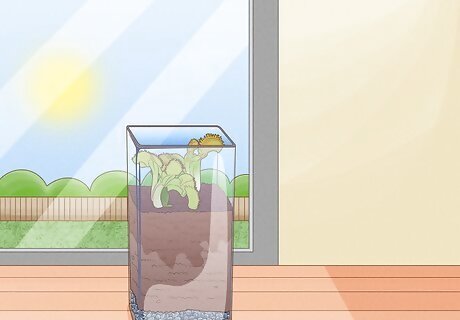
Give the Venus flytrap adequate sunlight. During the warmer months, you can keep it either outside (as long as the temperature doesn't dip too low at night) or place it in the window in the sun. Take care to water the Venus flytrap consistently so that the sun doesn't dry out the soil, especially during the summer. If your Venus flytrap is in a glass terrarium, make sure it doesn't get burned in the sun. If the plant looks like it's wilting a little, take it out of the sunlight after a few hours every day. If you'd rather not worry about making sure it gets enough sun, you can also grow Venus flytraps using a fluorescent grow lamp. Just make sure to keep the lamp 4 to 7 inches away from the plant. Turn on the grow lamp so that it provides a regular day's worth of light, and make sure to turn it off at night. If the leaves of the Venus flytrap aren't rosy pink, it's probably not getting enough sun.
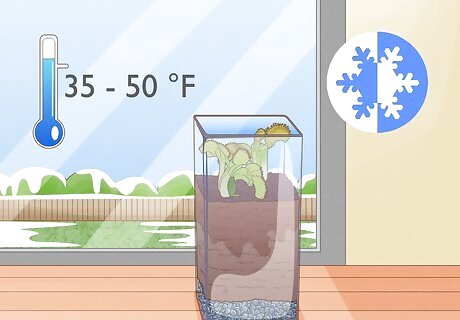
Overwinter the Venus flytrap. Venus flytraps have a natural dormancy period during the winter season. It usually lasts from September or October through February or March - the natural winter of the Carolinas. During this time, the Venus flytrap should be kept at a temperature of 35 to 50 °F (2 to 10 °C), with less sunlight than it receives during the summer months. If you live in growing zone 8 or below, you can keep the Venus flytrap outside all winter, as long as temperatures rarely drop below freezing. Expose the plant to light and warmth slowly at the spring equinox. If you live in a place with a colder winter, it's necessary to take the Venus flytrap inside. Keep it in the garage, shed or unheated greenhouse where it will receive protection from frost but still get sunlight and be exposed to cold enough temperatures to facilitate a dormancy period.
Feeding a Venus Flytrap
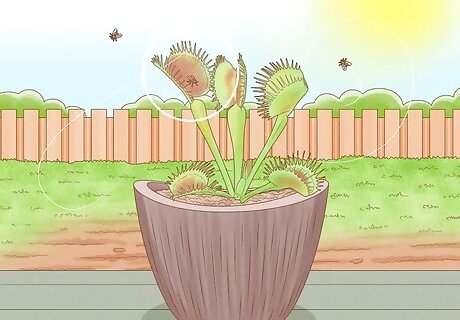
Let the Venus flytrap catch its food. If you keep your Venus flytrap outside, it will catch spiders and insects on its own (unless your outdoor environment is unnaturally sterile). When you see the leaves in a clasped position, the Venus flytrap has probably caught something.
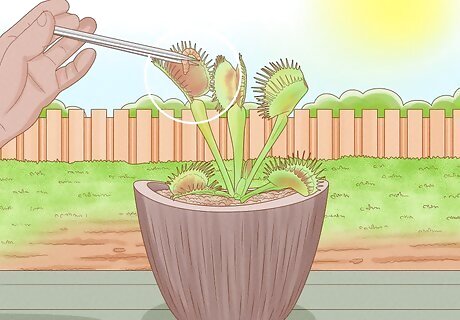
Feed the Venus flytrap mealworms or insects. If you want to feed the Venus flytrap - either because you're keeping it indoors or you just want to experience the excitement of watching it eat - you can use mealworms, insects or spiders that are small enough to fit in the leaf traps. Place the food inside one of the traps or release it inside the terrarium. The trap will close when the tiny hairs inside are triggered by the insect's movements. It's best to feed a Venus flytrap live bugs. The plant won’t close unless it senses movement, so feeding the plant dead bugs is not a good idea. You can purchase live or dead insects from a pet store, but you could also try catching your own. For smaller Venus flytraps, black flies are a good size. For larger traps, you could try small crickets. Venus flytraps can go months without eating, but if you're keeping yours indoors you should plan to feed it about once a month for best results.
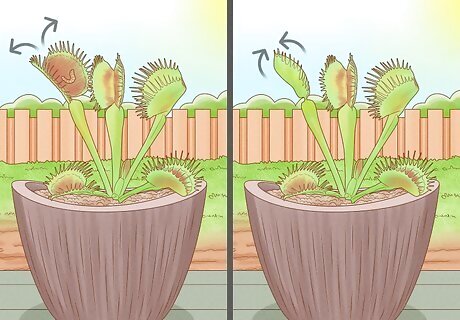
Watch for the trap to reopen. Once the Venus flytrap closes over its food, it takes at least 12 hours to digest its meal. Digestive enzymes break down the soft inner fluids of the insect or spider, leaving the exoskeleton intact. After about 12 hours, the trap will open and the empty exoskeleton will blow or wash away. If a small stone or another indigestible object ends up in the trap, it will release the object after 12 hours.
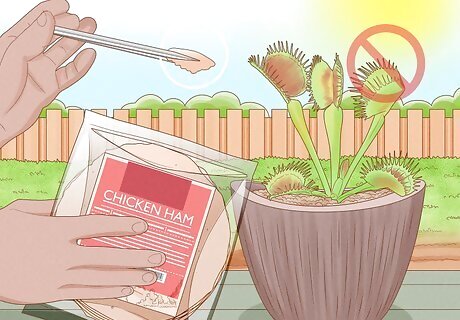
Don't feed it meat. You might be tempted to give the Venus flytrap a piece of ham or chicken, however, the plant does not have the right enzymes to digest animal meat. Feeding it anything besides spiders or insects could cause it to rot and die.
Growing New Plants
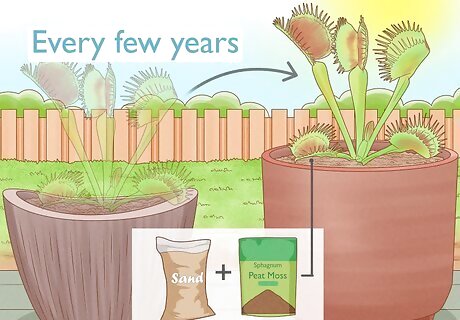
Repot the Venus flytrap every few years. Be sure to repot in a mixture of sphagnum moss and sand. You can repot the plant at any time, except when the plant is flowering.
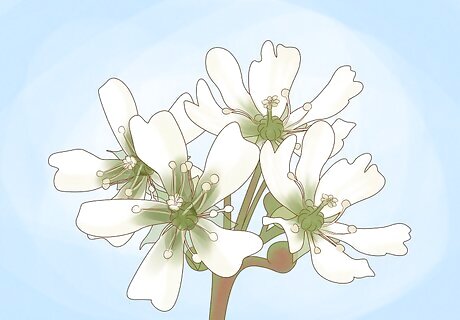
Allow it to flower. Pinch off the smaller flower stalks and keep a strong stalk with many heads. Let the flower stem grow high above the rest of the plant. This way the insects that pollinate the flowers won't get caught in the traps. Each flower will produce a seed pod. If you choose to cut off the stalk instead of allowing the plant flower, stick the stalk in the ground to encourage it to grow.
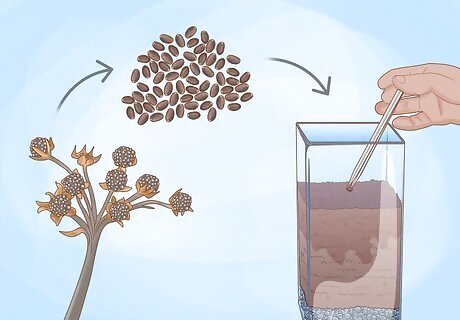
Plant the seeds of a mature plant as soon as possible. After a few years, when your Venus flytrap has matured, you can propagate it by planting the seeds it produces. Break open the seed pod to find the tiny black seeds. These seeds can be stored for up to a year in an airtight container in your refrigerator. Plant them in sphagnum moss, and keep them warm and moist until they sprout. Make sure that you keep the seeds moist by misting them several times a day. Expose the seeds to light for 13 hours per day as well. The seeds will germinate in anywhere from 5 to 30 days. After the seeds germinate, plant them on top of some peat moss or moss mixed with sand. Keep the planted seeds in a terrarium with a humid environment and a temperature of 70 to 85 degrees Fahrenheit.
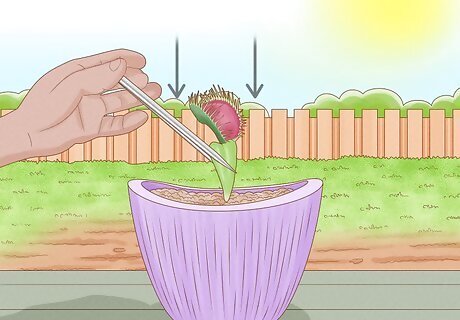
Try planting a leaf. Since the plants can grow from rhizomes, you could also try planting a leaf pinched off at the base to see if it sprouts. If conditions are right, the leaf will die and a tiny new plant will begin to grow. Find a healthy leaf that is outside of the rhizome and gently tug it downward. Trim off the top of the leaf and place it in good soil. Give it lots of water and light. It will take about two months to grow.
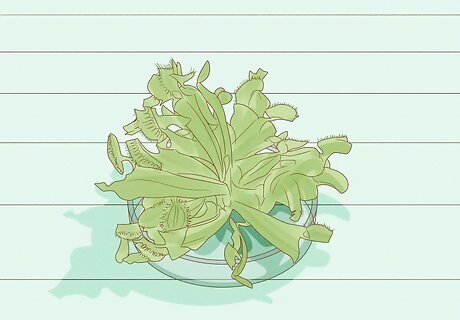
Grow a new plant from tissue. This method will produce man plants quickly, but it is an advanced method that involves growing the plant in a petri dish, so only attempt it if you are comfortable with this technique. Sterilize the tissue and the container with alcohol. Place the sterilized tissue in a nutrient and vitamin enriched mixture, and leave it be until leaf growth starts. This can take anywhere from 8 to 16 weeks. Move the plant to the standard growing medium.



















Comments
0 comment